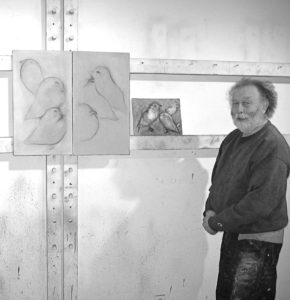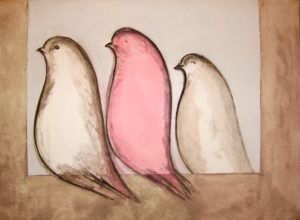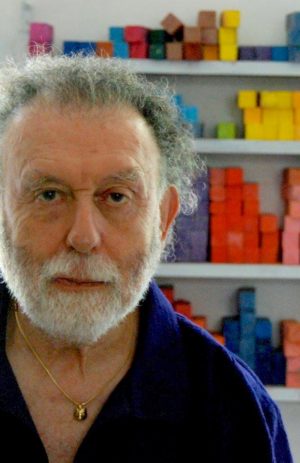The following interview with Basil King and Martha King took place on January 15, 2017 at the Kings’ residence in Brooklyn, New York.
SANJAY AGNIHOTRI:
Basil you just had two museum shows in North Carolina, both of them related to your history as a student at Black Mountain College, and now a solo show is about to open in New York.
BASIL KING:
Yes. It was very moving for me to return to North Carolina, to Asheville especially, 61 years after I entered Black Mountain College. And I was welcomed there as an exemplar of, well, the wall text at the show at Black Mountain College Museum, put it very nicely. It said:
As you experience Basil’s work, what becomes more and more a virtue is the inability to find in it a comfortable trademark phrase or look. Of course this doesn’t serve him well in an art world where an identifiable look, a replicable product, is important for sales. But it does, on the other hand, make him exemplary of the insider/outsider story that is Black Mountain College…
Now the John Molloy Gallery is showing a collection of my very recent works, all birds.
Back in 1970, for the first issue of Mulch magazine, I took photographs of pigeons in Central Park and on Cooper’s Square, at the back of Cooper Union. Then I painted about five different paintings of pigeons. These were my first bird works but on and off I have always been involved with the idea of a pigeon because I find them some of the most sophisticated of urban dwellers. They know how to live in this city better than just about everybody. They’re fantastic and as a child they just always interested me, how you could walk up and they’d know just when to get away from you. They know just when to eat.

Basil King with Birds
SANJAY A.:
You kind of almost step on them and they …
BASIL KING:
That’s right. And, boom! they’re off. I got involved with that. I am not a bird watcher. I don’t go out and watch birds but the birds out in our back yard, there’s a little tank they come to for water, and I’ve watched them. They have such strange shapes. Sometimes they actually look like fish when they’re down there … when they’re drinking the water, their body looks like a fish.
The show at John Molloy Gallery incorporates all this. Basically a bird and a fish and what it is to fly and then to perch. A lot of the paintings in this show are called ‘Perch’ because they sit on ledges, they sit in there or on there. I have them sometimes sitting in an atmosphere that is almost like a movie screen. It’s empty. Sometimes there’s the sky and sometimes there’s a person inside of it. I want somebody to believe that a bird is part of nature, not “Nature,” but our nature. They’re very close to us, I feel, and that’s the way I’ve painted them.
MARTHA KING:
Our friend Kimberly Lyons says that the pigeon is a traditional image for the spiritual in nature. Do you think you are dealing with spiritual issues in your paintings?
BASIL KING:
In the sense of not religious spirits, but spirits yes.
SANJAY A.:
Not mystical.
BASIL KING:
Not mystical but spirit yes. There are forces out there, there are. You sometimes get pinched, at least I have. I know I’ve got pinched by some. I don’t mean somebody, you know, a ghost. I mean a spirit has told me something, just told me something very quietly, and then I’ll do it. I’ll do it. Especially when I’m writing or painting. Basically it’s so different to write than to paint. Yesterday I painted for the first time in six weeks because this piece…
SANJAY A.:
Which is unusual for you. I mean you usually paint every day.
BASIL KING:
Well, I got involved with the piece I started writing, involving the playing cards, a tulip and fish and chips. I couldn’t paint. I was in there every goddam day writing it and I would tear it up and then I would start all over again.
MARTHA KING:
It’s getting published immediately, in fact, it’s already available in the latest issue of TALISMAN. Baz sent it to the editor, Ed Foster, not as a submission. He just wanted Ed to read it and the next he heard, Ed had put it into the current issue. I don’t think he’s ever had a piece published so quickly.
BASIL KING:
It was a day and a half after I sent it.
I sent it to him and I said, “Look, I’d like you to read this.” He edited my latest book, History Now and he’s done a marvelous job. He’s just a marvelous reader … he understands my work. I sent him the piece and I got back the next day, I’m putting it in Talisman.
SANJAY A.:
You have so many paintings on this particular theme of birds. In terms of the show, was it difficult to decide which ones to show? How did you determine what you were going to use?
BASIL KING:
John (Molloy) and I picked them out. And you’re right there are a whole lot of them. Way before the show Molloy took the big one called Perch, the first I did, up to his gallery.
SANJAY A.:
I think I’ve seen it.
BASIL KING:
Yes. Molloy’s got it hanging over a mantle piece he tells me. Actually he told me something very nice. Somebody came in and looked at it and said that’s one of the most tender things I’ve ever seen and it’s so strong at the same time.
Anyway, I had thought for this show, I wanted to show birds and works from another series called Windows. But he and I came down to okay, just the birds. Some big ones and many little paintings, little miniature paintings, I love to do those.

mixed media on canvas, 34″ x 48″ – Basil King, 2016 – currently at John Molloy Gallery
SANJAY A.:
You mentioned Mulch earlier. Were there drawings of pigeons in Mulch?
BASIL KING:
No. They were all photographs.
Those photographs were the ones that started me off. Because we were starting a magazine, what to put in it and how to start the first issue… it just seemed perfect.
I actually went to The Museum of Natural History. I spoke to an ornithologist and he was delighted because he said nobody ever comes to ask a question like this. He told me the craziest story. At some point, before World War 2, the city had the National Guard gather all the pigeons that they could find. They spent god knows how long gathering pigeons in the five boroughs and they took them up and put them on the border of New York and Canada…
They figured they’d fly into Canada. Within a few weeks the bastards were all back.
SANJAY A.:
Who would know that?
MARTHA KING:
They spent all this money because pigeons cause an awful lot of damage. Their shit is very acidic-and eats stuff away.
BASIL KING:
And you can’t find where they live.
MARTHA KING:
Oh yes, you can. All you have to do is watch.
BASIL KING:
But, it’s still hard.
MARTHA KING:
It took me years before I ever saw a baby pigeon because the babies, almost within a few days of birth, fluff their feathers out so big that they’re almost as big looking as an adult. If you see a nest and then you watch it every day you can see it. There used to be a nest in the subway station so I watched the whole process one year when I was commuting by subway.
BASIL KING:
The station… on Fourth Avenue?
MARTHA KING:
The elevated one on Fourth Avenue.
BASIL KING:
You showed me that one. Anyway, that’s what this show is about.
SANJAY A.:
Basil do you want to add anything else?
MARTHA KING:
Don’t forget pigeons and bird shapes are not the only things you paint. You tend to get involved in series and be very obsessive about a specific theme. In fact if you look at our website that’s what we show. We have The Green Man, Looking for the Green Man, Circuits, Baseball, Playing Cards, Family Photos, Basil’s Arc, and several Birds series.
BASIL KING:
Also Windows.
SANJAY A.:
The variety of work, Basil, I think there’s something to that …
BASIL KING:
I’ve done 190 paintings of playing cards.
SANJAY A.:
Just cards?
BASIL KING:
But I haven’t finished it. I’ve got to go back to it. I did all the kings and the queens and jacks. I did number cards up to eight.
MARTHA KING:
But you did them so long ago you may want to do them over again.
BASIL KING:
No, but if I start again I know it’ll be entirely different and that doesn’t bother me. It’s still part of the series. I have 190 paintings besides I don’t know how many drawings of the cards.
MARTHA KING:
You are as obsessed with them as you are with pigeons, truth be told.
BASIL KING:
Yeah but I gave up actually playing cards in 1960 …
MARTHA KING:
We used to host a poker game when we lived on the Lower East Side, a downtown poker game that went around from place to place. We had a big piece of green felt that went on our round table for when the poker game landed at our house. When I got pregnant, well, I cut it up and made a smock out of it to wear. Is that a pregnancy story or what?
BASIL KING:
It was beautiful too.
MARTHA KING:
It was a beautiful dark green felt smock.
BASIL KING:
…So, we stopped playing at our house, that’s all. We didn’t stop playing.
MARTHA KING:
But you stopped playing really regularly. You did it intermittently after that.
BASIL KING:
That’s true.
MARTHA KING:
The poker game that produced the funds for this house, which I’ve written about in a short story and it’s also in the memoirs, that was totally accidental. We didn’t know all those guys were going to come up to Cape Cod that weekend.
BASIL KING:
No we didn’t.
**
BASIL KING:
I have two things in mind coming next. I want to paint the Green Man with the Birds together.
SANJAY A.:
Fantastic.
BASIL KING:
Also, I’m going to start doing a series of couples.
SANJAY A.:
All right!
BASIL KING:
All these series are in my head all the time. What I do basically is, once I’m on it, I stay with that theme until I figure I’ve said enough about it at this time, but I know it will happen again because that’s what I live with.
MARTHA KING:
That’s what you feel about the birds right now. You’ve told me several times. I’ve finished with the birds for now.
BASIL KING:
Right, but I’ve got one more to complete and then I really will be finished with birds for now. I’m not sure if I’m going to start with the Green Man and Birds or with Couples. You know, Martha and I have been a couple for almost 60 years.
SANJAY A.:
That’s something.
BASIL KING:
You know, we were kids, right? We’ve gone through a lot of bullshit as well as good stuff. I figure, I’ve got to say something about it. I don’t particularly want to write it.
MARTHA KING:
I should hope not. Don’t invade our privacy. Thank you.
BASIL KING:
Yeah, that’s right. To paint it is something else.
Writing is a completely different thing to me. My problem in painting and in writing too, because of my English upbringing for 12 years, it is so hard not to be literal.
The English are so literal about everything. America has another, another sense of space, and that’s where Charles Olson is absolutely right. England speaks in a small country. Always speaks in a small country, like their bloody Underground. It’s hateful, that little pole, the little seats, everything is tight, tight, tight. Everybody is sitting with their legs together, together, together, together.
SANJAY A.:
I’ve experienced it. You know my mother was English.
MARTHA KING:
Well, I remember the first time we went to England together. It was your trip back, but my first ever to go there. After ten days I said, “Baz, let’s go see a Clint Eastwood Western.”
BASIL KING:
You wanted to see the space. We went and I forget what movie, but there was Montana….
MARTHA KING:
With the horses galloping.
SANJAY A.:
Yeah, yeah.
MARTHA KING:
And a blue sky.
BASIL KING:
The sky. That’s the other thing. Constable did it absolutely correctly. The clouds are about two feet away from you all the time in England.
SANJAY A.:
Right. Even when you’re in the fields in England … you feel like you’re still … There’s that feeling of almost claustrophobia or being cornered in.
MARTHA KING:
The weather is right in your face on top of you. It’s never coming from thousands of miles away.
SANJAY A.:
Well, I remember, I’ll never forget this. When we went to India, my father and I, we were in India for three weeks. We flew back and this was February. We went to London before coming back stateside. We were going to stay in London for a few days because we have relatives there, of course.
I’ll never forget the feeling of when we came out the underground and up those steps that lead to street level and the sky. You’re in India for three weeks and everything is so expansive and you arrive in England and it’s February. You can just feel the whole weight of the sky coming down on you and constantly collapsing around you.
BASIL KING:
Yeah, that’s what I’m talking about. Constable really does it that way. He has the clouds two feet away from you. Just two feet away from you all the time. Whereas, there’s that space here in America. I was brought up for 12 years with those clouds. I remember how you never really saw a lot of sky. There were always clouds. Summertime or winter, I remember clouds.
MARTHA KING:
Can you talk a little bit about why you decided to name the show Bird Scripts when actually in terms of the works that you’re showing, they are from several different bird series. You have Bird Scripts, you have City Birds, you have A Pigeon in Delacroix’s Garden. You have a number of other series that are bird paintings. Why did you decide to call this whole show, Bird Scripts?
BASIL KING:
Because Martha’s sister sent me a book about Chinese calligraphy. It has a whole chapter on bird script which was basically started to record business.
Business transactions, et cetera, et cetera. Slowly, they developed into playing cards. Then from China, the system went to Persia and they’re not quite sure …
MARTHA KING:
Before they were cards used for playing a game, they were cards that had symbols on them that referred to specific stuff.
BASIL KING:
Exactly.
MARTHA KING:
They were used as receipts and so on.
BASIL KING:
Then slowly, what happened was they developed into playing cards.
MARTHA KING:
People began to play games with them.
BASIL KING:
Then they developed into true playing cards. They traveled from Persia, then to Egypt. The Silk Road played a part. Finally, by the end of the 13th century playing cards hit Europe. The Germans went bananas.
They’re the first ones to have these wonderful engravings and drawings of families sitting around playing cards. Not the royalty, ordinary families.
So I thought Bird Scripts just had an encompassing name.
SANJAY A.:
I think it’s a great title, Bird Scripts.
MARTHA KING:
I think you also liked it, if I could interject, because bird and script joins together images and writing.
BASIL KING:
Oh yeah, absolutely.
MARTHA KING:
It also incorporates your interest in non-human consciousness, which I think is one of the reasons you are so interested in birds.
BASIL KING:
Explain yourself. Non-human consciousness?
MARTHA KING:
You think the birds have consciousness of themselves and what they’re doing.
BASIL KING:
I do.
MARTHA KING:
They’re not human.
BASIL KING:
That’s right.
MARTHA KING:
And you’re interested in that other kind of consciousness. You see out on the street every day. The bus comes along and the pigeons are busy eating and you think you’re going to see a pigeon get squashed into nothing and at the last minute, the pigeon is up and out of the way.
BASIL KING:
The thing about it is, birds interest me more than cats.
MARTHA KING:
Well, actually birds are further away from us than cats. Cats are mammals. Cats are related to us much more closely biologically than birds are. Birds separated from us on the great tree of life way back when, back in the dinosaur days, so the leap, the recognition that you have with an animal like a dog or a cat or even a mouse is much more viscerally related to you because we are all mammals.
SANJAY A.:
Anything else Baz you want to add into this for now?
BASIL KING:
I think we’ve covered a lot about how I became interested in birds and why I go on painting them. Thank you both.
Portrait of Basil King by Sanjay Agnihotri



Comments are closed.